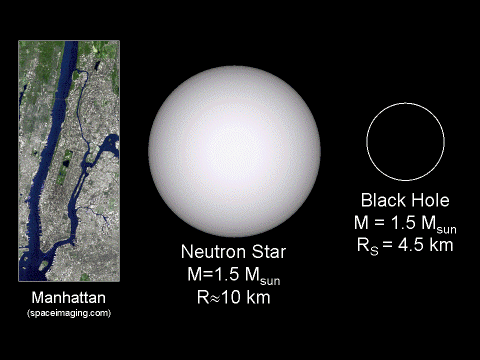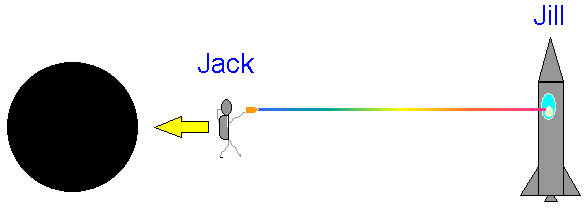

|
Astronomy 162:
Introduction to Stars, Galaxies, & the Universe
Prof. Richard Pogge, MTWThF 9:30
|
Lecture 20: Black Holes
Readings: Ch 24, sections 24-3, 5, 6, 7 & 8
- Black Holes are totally collapsed objects
- gravity so strong not even light can escape
- predicted by General Relativity
- Schwarzschild Radius & Event Horizon
- Find them by their Gravity
- X-ray Binary Stars
- Black Hole Evaporation
- Emit "Hawking Radiation"
Gravity's Final Victory
A star more massive than about 18 Msun would leave behind a
post-supernova core this is larger than 2-3 Msun:
Neutron degeneracy pressure would fail and nothing can stop its
gravitational collapse.
Core would collapse into a singularity, and object with
- zero radius
- infinite density
Black Hole
The Ultimate Extreme Object
- Gravity is so strong that nothing, not even light, can escape.
- Infalling matter is shredded by powerful tides and crushed
to infinite density.
- Escape speed exceeds the speed of light.
Becomes a Black Hole:
- "Black" because they neither emit nor reflect light.
- "Hole" because nothing entering can ever escape.
Schwarzschild Radius
Light cannot escape from a Black Hole if it comes from a radius
closer than the Schwarzschild Radius, RS to
the singularity:

Where M = Mass of the Black Hole
A black hole with a mass of 1 Msun would
have a Schwarzschild Radius of RS=3 km.
Compare this with a typical 0.6 Msun White Dwarf, which
would have a radius of about 1 Rearth (6370km), and
a 1.4 Msun neutron star, which would have a radius of about 10km.

- Comparison of a 1.5 Msun Black Hole and Neutron Star with
Island of Manhattan for scale.
RS is named for German physicist Karl Schwarzschild who in
1916 was one of the first people to explore the implications of
Einstein's then-new General Theory of Relativity, the modern theory of
Gravity.
The Event Horizon
RS defines the "Event Horizon" surrounding
the black hole's singularity:
- Events occurring inside RS are invisible to the outside
universe.
- Anything closer to the singularity than RS can never
leave the black hole
- The Event Horizon hides the singularity from the outside universe.
The Event Horizon marks the "Point of No Return" for
objects falling into a Black Hole.
Gravity around Black Holes
Far away from a black hole:
- Gravity is the same as that of star of the same mass.
Close to a black hole:
- R < 3 RS, there are no stable orbits - all matter gets
sucked in.
- At R = 1.5 RS, photons would orbit in a circle!
Journey to a Black Hole: A Thought Experiment
Two observers: Jack & Jill
- Jack, in a spacesuit, is falling into a black hole. He is carrying
a low-power laser beacon that flashes a beam of blue light once a
second.
- Jill is orbiting the black hole in a starship at a safe distance
away in a stable circular orbit. She watches Jack fall in by monitoring
the incoming flashes from his laser beacon.

He Said, She Said...
From Jack's point of view:
- He sees the ship getting further away.
- He flashes his blue laser at Jill once a second by his watch.
From Jill's point of view:
- Each laser flash take longer to arrive than the last
- Each laser flash become redder and fainter than
the one before it.
Near the Event Horizon...
Jack Sees:
- His blue laser flash every second by his watch
- The outside world looks oddly distorted (positions of stars have
changed since he started).
Jill Sees:
- Jack's laser flashing about once every hour.
- The laser flashes are now shifted to radio wavelengths, and
- the flashes are getting fainter with each flash.
Down the hole...
Jill Sees:
- One last flash from Jack's laser after a long delay (months?)
- The last flash is very faint and at very long radio wavelengths.
- She never sees another flash from Jack...
Jack Sees:
- The universe appear to vanish as he crosses the event horizon
- He gets shredded by strong tides near the singularity and crushed
to infinite density.
Moral:
The powerful gravity of a black hole warps space and time around it:
- Time appears to stand still at the event horizon as seen by
a distant observer.
- Time flows as it always does as seen by an infalling astronaut.
- Light emerging from near the black hole is
Gravitationally Redshifted to longer (red) wavelengths.
Take a Virtual
Trip to a Black Hole or Neutron Star. Pictures & movies by
relativist Robert Nemiroff at the Michigan Technical University.
Seeing what cannot be seen...
- Question:
- If black holes are black, how can we hope to see them?
- Answer:
- Look for the effects of their gravity on their surroundings.
- Look for stars orbiting around an unseen massive object
- Look for X-rays emitted by gas that is superheated as it
falls into a black hole.
X-Ray Binaries
Bright, variable X-ray sources identified by X-ray observatory satellites:
- Spectroscopic binary with only one set of spectral lines -
the second object is invisible.
- Gas from the visible star is dumped on the companion, heats
up, and emits X-rays.
Estimate the mass of the unseen companion from the parameters of its
orbit.
- A black hole candidate, conservatively, would be a system in which
the mass of the unseen companion was larger than 4 Msun,
the more massive the better.
Black Hole Candidates
A number of X-ray binaries have been found with unseen companions with
Masses > 4 Msun, too big for a Neutron Star.
Examples:
- Cygnus X-1: M = 6-10 Msun
- V404 Cygni: M > 6 Msun
- LMC X-3: M = 7-10 Msun
None are as yet iron-clad cases, but in general things are
looking pretty good. Most of the current work is going into refining
the mass estimates, and looking for other evidence that we are really
dealing with a black hole.
Black Holes are not totally Black!
"Classical" General Relativity says:
- Black Holes are totally black
- Can only grow in mass and size
- Last forever (nothing gets out once inside)
But, General Relativity does not include the effects of
Quantum Mechanics.
Evaporating Black Holes
Black Holes evaporate slowly by emitting subatomic particles and photons via
"Hawking Radiation":
- Very cold thermal radiation (Temperatures of ~10 nanoKelvin)
- Bigger Black holes are colder
The smaller the mass, the hotter the black hole, and
so the faster the evaporation.
For black holes in the real universe, the evaporation rate is VERY slow:
- A 3 Msun black hole would require about 1063
years to completely evaporate.
- This is about 1053 times the present age of the Universe.
Probably unimportant today, but it could be an important process in
the distant future of the Universe.
A Final Word
Physicist John
Archibald Wheeler (b. 1911), who coined the term "black hole", has
been one of the most innovative thinkers on space and time. The
singularity at the center of the black hole, which we passed over
quickly, is not a simple beast. Its existance, at least in the
classical theory of relativity, is a real problem that is telling us
about the limits of our ideas. Prof. Wheeler has put it this way:
[The black hole] "teaches us that space can be crumpled like
a piece of paper into an infinitesimal dot, that time can be
extinguished like a blown-out flame, and that the laws of physics
that we regard as 'sacred', as immutable, are anything but."
from "Geons, Black Holes, & Quantum Foams: A Life in Physics"
by Wheeler and Ford (1998, AIP Press)
Return to [
Unit 3 Index
|
Astronomy 162 Main Page
]
Updated: 2006 February 1
Copyright © Richard W. Pogge, All Rights Reserved.



